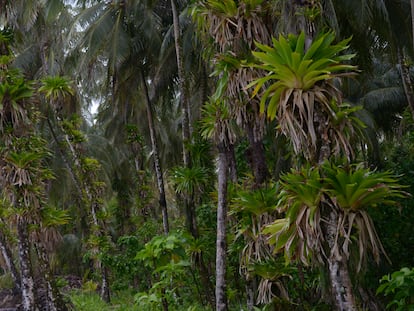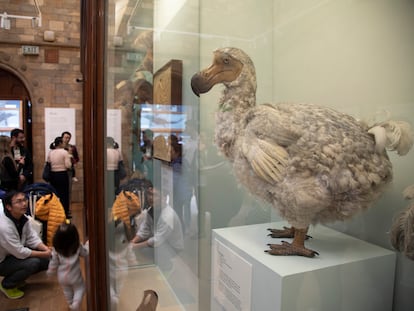Anthropologist Paul Barnes: ‘The conservation of species depends almost exclusively on philanthropy and goodwill’
The Mary River turtle and the aye-aye, a primate endemic to Madagascar, are among the endangered and little-known animals receiving help from the Zoological Society of London’s EDGE of Existence program
The aye-aye, one of the world’s rarest primates, the gecko and the shoebill bird are some of conservation’s great forgotten species. The Zoological Society of London’s EDGE of Existence program dedicates its efforts to the conservation of these little-known, but unique and irreplaceable species. Environmental anthropologist Dr. Paul Barnes, 37, is the director of the project. He says that the program could not function “without the passion and commitment” of local conservationists on the ground. Barnes’s job is to fund those local researchers and ensure that resources reach the regions and animals that need them most, beyond the well-known emblematic species. In 2023, the EDGE of Existence program received the BBVA World Biodiversity Conservation Award.
Question. What is the goal of the EDGE of Existence program?
Answer. There are highly endangered animals that get a lot of attention, like elephants, but we look at the underdogs, the forgotten ones, that are unique and irreplaceable. That’s where we try to channel training and financial resources. We help local conservationists keep the species in their countries of origin. We do this primarily through a fellowship scheme.
Q. What do you consider to be a species on the edge?
A. They are the ones that are listed as endangered or critically endangered, and in addition they are evolutionarily distinct — they have no relatives — so their disappearance would mean the extinction of an entire evolutionary line. They are unique because of their singularity, because of the way they live and behave.
Q. What are some examples?
A. In Spain, for example, it could be the Pyrenean desman or Egyptian vultures. Our logo is the Australian echidna [a species of hedgehog with a long beak which has no known subspecies]. There are also the pangolins and shoebills. What other bird species is like that?
Q. Which are the most endangered species?
A. There are many, but the ones that are having the worst time are probably the ones which live in small, specific areas. For example, we are working with the Colombian dwarf gecko, an incredibly small lizard, which lives in a tropical dry forest area in Colombia, and the rock gecko, which has been located in a small rocky outcrop in Paraguay. These are such specific locations that anything could wipe them out: a natural disaster, a flood, something like that, and there would be no replacement. There are many species in the world that we don’t even know how they are doing. Think about amphibians that are often confined to very specific places like high altitude mountains in the rainforest, which are incredibly sensitive to climate change and disease.
Q. Your network of collaborators is essential to the functioning of the program, isn’t it?
A. Yes, we have a fellowship, which has already benefited almost 140 local researchers around the world, who train others. Much of the work we do in the future will come from them, because we go to them for support; they are the ones who know the place, the people, the political situation.... We also establish scientific cooperation with universities and other conservation organizations. But without the passion and commitment of the conservationists in the country we support, none of this would have been achieved. Everything depends on those scientists.
Q. Have you achieved your objectives?
A. Every fellowship we have awarded has been a great success. It shows that if you invest in people, if you put the time in, conservation works. We have seen species become less threatened. There are successes, covering 157 species in 47 countries. I think our failure as a program is not being able to help more. We have to find a way to reach more places, more people.
Q. What did the fame of the Mary River turtle in Australia — which is known for its green algae hair — mean to you?
A. It was one of those stories that captures people’s imagination, that helps make a connection with the species. They thought it was a funny animal and it went viral. Before we put out press releases about it, no one would have thought it would become a conservation icon. To make people care about something, you have to try to create that bond. Take, for example, the aye-aye, a species of lemur unique to Madagascar. You look at a picture and it’s incredibly ugly, but at the same time it’s very funny with the long finger that it uses to catch the worms. You have to build a bridge for people to get close to it. When you do that and you capture people’s imagination, they are receptive. If you live in Spain and there are species going extinct on a mountaintop in Cameroon, how do you make people understand that this is potentially a problem? That’s one of our biggest challenges.
Q. Does your work confirm that we are in the sixth mass extinction?
A. Yes, the evidence shows that we are losing many species. I think it is mainly due to habitat destruction, caused by humans and climate change. As temperatures rise, their environment changes, diseases emerge and there is no place for them.
Q. Why is this loss of biodiversity so significant?
A. Diversity represents everything that is interesting in the world, including cultures and languages; that is what makes it unique and resilient. If we lose species, whole branches of evolutionary history will disappear, we’ll lose part of the system’s resilience to be able to adapt and withstand shocks.
Q. Do you think that a lot of space is dedicated to fossil fuels at summits and too little to biodiversity?
A. Historically, that has been the case, but there is increasing pressure to recognize that everything goes together. Whether that translates into recognition and political will is another question, and we will see what happens in the next few years. Actually, my work doesn’t have much to do with climate change, and I’m not sure how things should be done. But I would like to see more political ambition in my own country to try to lead on these issues. We have backtracked on some of our commitments and have been licensing new fossil fuels. I would like to see an end to that, I really would. I think people are very aware of what’s going on, especially the younger generations.
Q. Do you think that we have time to stop it?
A. Yes, definitely, we just have to do it. There is no point in despairing; there has to be the will to do it and to make it known that there are measures that work. One of the problems is that conservation depends almost exclusively on philanthropy and the good will of the organizations that carry it out. We need to rapidly scale it up and open up new funding mechanisms.
Sign up for our weekly newsletter to get more English-language news coverage from EL PAÍS USA Edition
Tu suscripción se está usando en otro dispositivo
¿Quieres añadir otro usuario a tu suscripción?
Si continúas leyendo en este dispositivo, no se podrá leer en el otro.
FlechaTu suscripción se está usando en otro dispositivo y solo puedes acceder a EL PAÍS desde un dispositivo a la vez.
Si quieres compartir tu cuenta, cambia tu suscripción a la modalidad Premium, así podrás añadir otro usuario. Cada uno accederá con su propia cuenta de email, lo que os permitirá personalizar vuestra experiencia en EL PAÍS.
¿Tienes una suscripción de empresa? Accede aquí para contratar más cuentas.
En el caso de no saber quién está usando tu cuenta, te recomendamos cambiar tu contraseña aquí.
Si decides continuar compartiendo tu cuenta, este mensaje se mostrará en tu dispositivo y en el de la otra persona que está usando tu cuenta de forma indefinida, afectando a tu experiencia de lectura. Puedes consultar aquí los términos y condiciones de la suscripción digital.
More information
Últimas noticias
Most viewed
- Sinaloa Cartel war is taking its toll on Los Chapitos
- Oona Chaplin: ‘I told James Cameron that I was living in a treehouse and starting a permaculture project with a friend’
- Reinhard Genzel, Nobel laureate in physics: ‘One-minute videos will never give you the truth’
- Why the price of coffee has skyrocketed: from Brazilian plantations to specialty coffee houses
- Silver prices are going crazy: This is what’s fueling the rally











































